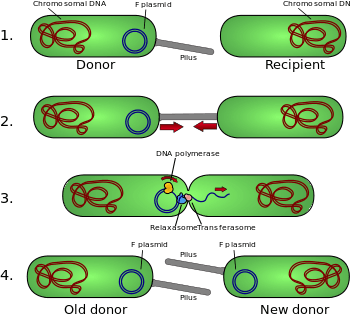Pilus

A pilus (Latin for 'hair'; plural : pili) is a hair like appendage found on the surface of many bacteria.[1] The terms pilus and fimbria (Latin for 'fringe'; plural: fimbriae) can be used interchangeably, although some researchers reserve the term pilus for the appendage required for bacterial conjugation. All pili in the latter sense are primarily composed of pilin proteins, which are oligomeric.
Dozens of these structures can exist on the bacteria. Some bacterial viruses or bacteriophages attach to receptors on pili at the start of their reproductive cycle.
Pili are antigenic. They are also fragile and constantly replaced, sometimes with pili of different composition, resulting in altered antigenicity. Specific host responses to old pili structure are not effective on the new structure. Recombination genes of pili code for variable (V) and constant (C) regions of the pili (similar to immunoglobulin diversity).
Types
Conjugative pili
Conjugative pili allow for the transfer of DNA between bacteria, in the process of bacterial conjugation. They are sometimes called "sex pili", in analogy to sexual reproduction, because they allow for the exchange of genes via the formation of "mating pairs". Perhaps the most well-studied is the F pilus of Escherichia coli, encoded by the F plasmid or fertility factor.
A pilus is typically 6 to 7 nm in diameter. During conjugation, a pilus emerging from the donor bacterium ensnares the recipient bacterium, draws it in close, and eventually triggers the formation of a mating bridge, which establishes direct contact and the formation of a controlled pore that allows transfer of DNA from the donor to the recipient. Typically, the DNA transferred consists of the genes required to make and transfer pili (often encoded on a plasmid), and so is a kind of selfish DNA; however, other pieces of DNA are often co-transferred and this can result in dissemination of genetic traits throughout a bacterial population, such as antibiotic resistance. Not all bacteria can make conjugative pili, but conjugation can occur between bacteria of different species.
Type IV pili
Some pili, called type IV pili, generate motile forces.[2] The external ends of the pili adhere to a solid substrate, either the surface to which the bacterium is attached or to other bacteria, and when the pilus contracts, it pulls the bacterium forward, like a grappling hook. Movement produced by type IV pili is typically jerky, so it is called twitching motility, as distinct from other forms of bacterial motility, such as that produced by flagella. However, some bacteria, for example Myxococcus xanthus, exhibit gliding motility. Bacterial type IV pilins are similar in structure to the component flagellins of archaeal flagella.[3]
Genetic transformation is the process by which a recipient bacterial cell takes up DNA from a neighboring cell and integrates this DNA into the recipient’s genome by homologous recombination. In Neisseria meningitidis (also called meningococcus), DNA transformation requires the presence of short DNA uptake sequences (DUSs) which are 9-10 monomers residing in coding regions of the donor DNA. Specific recognition of DUSs is mediated by a type IV pilin.[4] Menningococcal type IV pili bind DNA through the minor pilin ComP via an electropositive stripe that is predicted to be exposed on the filament's surface. ComP displays an exquisite binding preference for selective DUSs. The distribution of DUSs within the N. meningitides genome favors certain genes, suggesting that there is a bias for genes involved in genomic maintenance and repair.[5][6]
Fimbriae
Attachment of bacteria to host surfaces is required for colonization during infection or to initiate formation of a biofilm. A fimbria is a short pilus that is used to attach the bacterium to a surface. They are sometimes called "attachment pili". Fimbriae are either located at the poles of a cell, or are evenly spread over its entire surface. Mutant bacteria that lack fimbriae cannot adhere to their usual target surfaces, thus cannot cause diseases.
Some fimbriae can contain lectins. The lectins are necessary to adhere to target cells because they can recognize oligosaccharide units on the surface of these target cells. Other fimbriae bind to components of the extracellular matrix.
Fimbriae are found in Gram-negative bacteria. In Gram-positive bacteria, the pilin subunits are covalently linked.
Some aerobic bacteria form a thin layer at the surface of a broth culture. This layer, called a pellicle, consists of many aerobic bacteria that adhere to the surface by their fimbriae or "attachment pili". Thus, fimbriae allow the aerobic bacteria to remain on the broth, from which they take nutrients, while they congregate near the air.
See also
References
- ↑ "pilus" at Dorland's Medical Dictionary
- ↑ Mattick JS (2002). "Type IV pili and twitching motility". Annu. Rev. Microbiol. 56 (1): 289–314. doi:10.1146/annurev.micro.56.012302.160938. PMID 12142488.
- ↑ Jarrell; et al. (2009). "Archaeal Flagella and Pili". Pili and Flagella: Current Research and Future Trends. Caister Academic Press. ISBN 978-1-904455-48-6.
- ↑ Cehovin A, Simpson PJ, McDowell MA, Brown DR, Noschese R, Pallett M, Brady J, Baldwin GS, Lea SM, Matthews SJ, Pelicic V (2013). "Specific DNA recognition mediated by a type IV pilin". Proc. Natl. Acad. Sci. U.S.A. 110 (8): 3065–70. doi:10.1073/pnas.1218832110. PMC 3581936
 . PMID 23386723.
. PMID 23386723. - ↑ Davidsen T, Rødland EA, Lagesen K, Seeberg E, Rognes T, Tønjum T (2004). "Biased distribution of DNA uptake sequences towards genome maintenance genes". Nucleic Acids Res. 32 (3): 1050–8. doi:10.1093/nar/gkh255. PMC 373393
 . PMID 14960717.
. PMID 14960717. - ↑ Caugant DA, Maiden MC (2009). "Meningococcal carriage and disease--population biology and evolution". Vaccine. 27 Suppl 2: B64–70. doi:10.1016/j.vaccine.2009.04.061. PMC 2719693
 . PMID 19464092.
. PMID 19464092.
External links
- Sex Pilus at the US National Library of Medicine Medical Subject Headings (MeSH)
- Bacterial Pilus at the US National Library of Medicine Medical Subject Headings (MeSH)